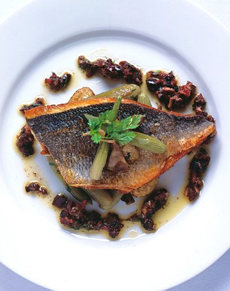TIP OF THE DAY: Cooking Fish
|
On Saturday we provided fish-buying tips from chef Scott Leibfried of Arch Rock Fish restaurant in Santa Barbara. Today, Chef Scott provides some fish-cooking tips to turn home cooks into chefs de poisson. |
Olive oil poached salmon, skin off. Here‘s the recipe. Photo courtesy Pom Wonderful. |
|
|
BREAKING DOWN A FISH If you like to wield a knife, you can save money by purchasing a whole fish rather than fillets. There are two groups of fish: round fish (bass, salmon, snapper) and flatfish (flounder, halibut, sole). The different shapes mean different skeletal structure. Chef Scott explains how to break down the more popular round fish: |
||
 Grilled salmon, skin on, with sautéed black olives. Photo courtesy Payard | New York City. |
GRILLED SNAPPER VERACRUZ: AN ADVANCED RECIPE
Ingredients For 4 Servings |
|
|
Preparation: Fish 1. TURN grill on; you want it to be fairly hot, so the fish cooks quickly. Oil the grill with a cloth: This avoids sticking and breaking. 2. OIL the fillets and season with salt and pepper. Don’t drench the fish with oil, just brush it. Otherwise, the grill may flare up from the excess oil. Place the fillets on the grill and leave them there. Don’t play with the fish; let the grill marks set in. 3. FLIP fish with a spatula once, halfway through cooking. Be gentle: Fish is delicate, unlike a burger or chicken. If the grill is hot enough and oiled correctly, the fillets should neither stick nor break. This, of course, takes practice! 4. COVER and let the fish finish grilling. The process shouldn’t take longer then 8 minutes. The fish will continue to cook when taken off the grill. If undercooked you can return it to the grill (in restaurants they finish it in the oven). But try the undercooked fish: The flavor is more elegant and never “fishy.” The greatest sin is dry, overcooked fish. 5. ADD sauce and serve. Plate it chef-style: Place the fish atop a bed of starch (noodles, potatoes, rice) or green vegetables (kale, spinach, zucchini) and drizzle the sauce around the circumference of the plate. 1. COMBINE onion, garlic and jalapeño in a pan with oil; sweat them over medium high heat. 2. ADD tomatoes, olives, capers, thyme and cilantro. 3. SEASON with salt and pepper. 4. GARNISH with cilantro; or for something more special, fried capers. Filet (fee-LAY) is French, fillet (FILL-let) is British. They mean the same thing: a boneless cut or slice of fish or meat.
|
||
